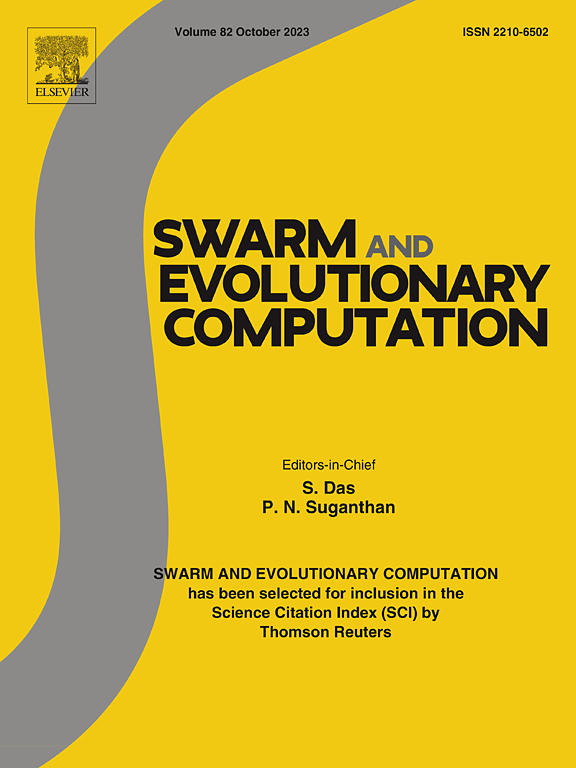通过无训练的NAS进行少次学习的进化神经网络
IF 8.5
1区 计算机科学
Q1 COMPUTER SCIENCE, ARTIFICIAL INTELLIGENCE
引用次数: 0
摘要
改进Few-Shot Learning (FSL)性能的努力主要集中在引入更多的FSL方法。然而,神经网络在FSL中的作用却没有得到广泛的分析。在本文中,我们旨在弥合神经网络和神经结构搜索之间的差距,并从无训练神经结构搜索(NAS)的角度提出一种新的神经结构搜索方法。具体而言,我们首先深入分析了针对FSL的基于模型不可知论元学习(MAML)的方法,并发现基于MAML的FSL方法的主要瓶颈是由于MAML的二阶性。为了解决这个问题,我们引入了一个新的定理来保证MAML的一阶收敛性。然后,我们提出了一种新颖的FNAS框架,在初始化时有效地设计FSL的神经结构。FNAS结合了神经切线核(NTK)和Fisher信息矩阵(FIM)的原理,引入了一种无需训练的代理。该代理以不需要训练的方式从给定的搜索空间中有效地捕获候选体系结构的表达性。为了进一步提高搜索效率,我们将该代理集成到改进的进化算法中,在最小的计算预算下全面探索架构空间。在主流基准测试上的实验验证表明,FNAS实现了最先进的性能,同时在计算预算方面比其竞争对手成本更低。本文章由计算机程序翻译,如有差异,请以英文原文为准。
Evolving neural network for few-shot learning via training-free NAS
Efforts to improve the performance of Few-Shot Learning (FSL) have mainly centered around introducing more FSL approaches. However, the role of neural networks in FSL is less extensively analyzed. In this paper, we aim to bridge the gap between neural networks and FSL, and to propose a novel method from a training-free Neural Architecture Search (NAS) perspective to FSL. Specifically, we first conduct an in-depth analysis of Model Agnostic Meta Learning (MAML) based methods tailored to FSL, and find the main bottleneck of MAML-based methods for FSL that is attributed to the second-order of MAML. To address this issue, we introduce a new Theorem to ensure the first-order convergence of MAML. Then, we propose a novel Few-shot Neural Architecture Search (FNAS) framework to efficiently design neural architectures for FSL at initialization. FNAS introduces a training-free proxy by combining principles from Neural Tangent Kernel (NTK) and Fisher Information Matrix (FIM). This proxy effectively captures the expressivity of candidate architectures from the given search space in a training-free manner. To further enhance search efficiency, we integrate this proxy into an improved evolutionary algorithm to comprehensively explore the architecture space under minimal computational budgets. Experimental validation on mainstream benchmarks demonstrates that FNAS achieves state-of-the-art performance while being less costly in terms of computational budgets than its competitors.
求助全文
通过发布文献求助,成功后即可免费获取论文全文。
去求助
来源期刊

Swarm and Evolutionary Computation
COMPUTER SCIENCE, ARTIFICIAL INTELLIGENCEC-COMPUTER SCIENCE, THEORY & METHODS
CiteScore
16.00
自引率
12.00%
发文量
169
期刊介绍:
Swarm and Evolutionary Computation is a pioneering peer-reviewed journal focused on the latest research and advancements in nature-inspired intelligent computation using swarm and evolutionary algorithms. It covers theoretical, experimental, and practical aspects of these paradigms and their hybrids, promoting interdisciplinary research. The journal prioritizes the publication of high-quality, original articles that push the boundaries of evolutionary computation and swarm intelligence. Additionally, it welcomes survey papers on current topics and novel applications. Topics of interest include but are not limited to: Genetic Algorithms, and Genetic Programming, Evolution Strategies, and Evolutionary Programming, Differential Evolution, Artificial Immune Systems, Particle Swarms, Ant Colony, Bacterial Foraging, Artificial Bees, Fireflies Algorithm, Harmony Search, Artificial Life, Digital Organisms, Estimation of Distribution Algorithms, Stochastic Diffusion Search, Quantum Computing, Nano Computing, Membrane Computing, Human-centric Computing, Hybridization of Algorithms, Memetic Computing, Autonomic Computing, Self-organizing systems, Combinatorial, Discrete, Binary, Constrained, Multi-objective, Multi-modal, Dynamic, and Large-scale Optimization.
 求助内容:
求助内容: 应助结果提醒方式:
应助结果提醒方式:


